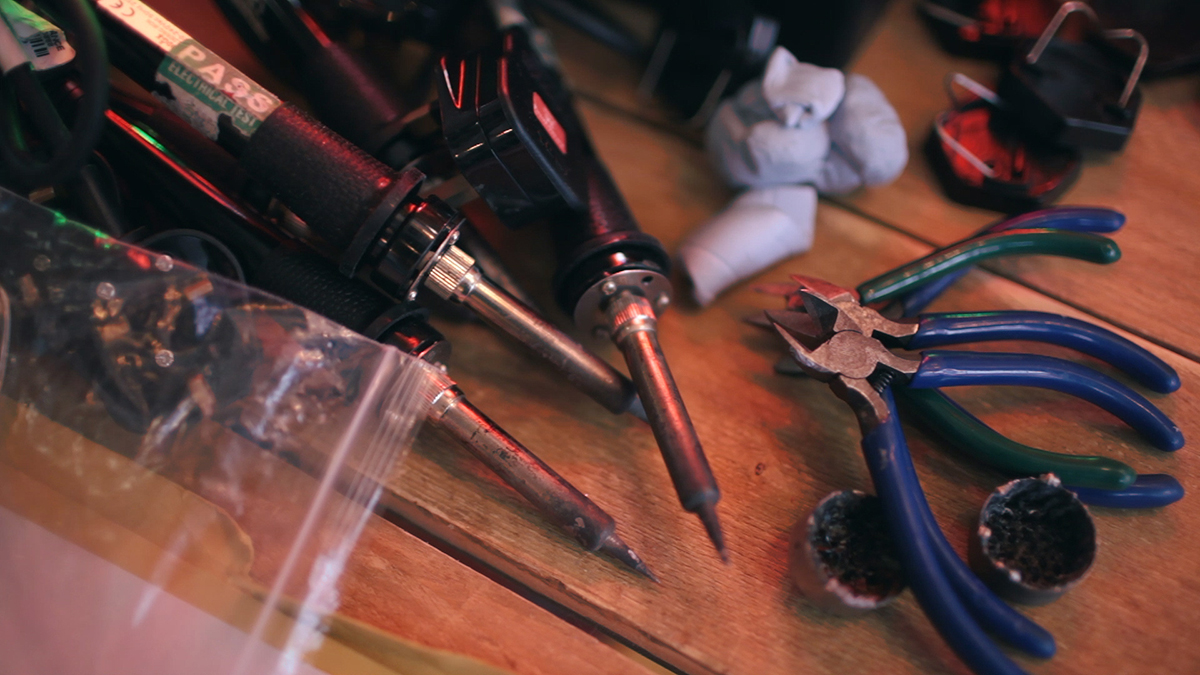How to build your first synthesizer and live to tell the tale
The 55mm wavetable synth from Dirty Electronics and Max Wainwright is a perfect starter project
Building your own synth for the first time is a daunting task - the threat of ruining everything with one errant swathe of the soldering iron really does hone the senses. Which is handy, because everything is so darn tiny and fiddly.
“Blu Tack is like a third hand,” says John Richards, of Dirty Electronics fame, as he dishes out blobs of the blue stuff, along with small bags of resistors, chipsets and capacitors. We are sitting in the very small vestibule area of Soho Radio studio in London, known as Jäger Soho, awaiting his expert tutelage on building the 57mm wavetable synth.
The ‘live radio’ part of Soho Radio is beyond a big glass door behind us, while a larger studio space, located downstairs, plays home to podcast recording. We are even treated to visits from ex-MPs; George Osborne and Nick Clegg at one point, who seem to be guests on a cultural podcast of some kind.
If you ever wanted to see the former Chancellor of the Exchequer imitate a scared gazelle, then just make him walk through a small room of eager synth DIY-ists brandishing soldering irons.
What we will say is if you ever want to see the former Chancellor of the Exchequer imitate a scared gazelle, then just make him walk through a small room of eager synth DIY-ists brandishing soldering irons.
As we marvel at the close proximity of such eminent figures of recent British political history, John also remarks that ex-Downing Street Press Secretary, Alistair Campbell, was in the previous day and even took time to sit down and find out more about the workshops - in your face Osborne!

The political sideshow just adds to the very laidback nature of John’s workshops. As our guide through this journey of discovery, he treats us to a mixture of anecdotes and handy soldering tips - perfect for the self-taught among us.
The 57mm is a digital wavetable synth designed by John Richards and Max Wainwright in collaboration.
Debuted at Noisexistence festival in Hamburg, control comes in the form of a button, microphone and several touch points. The wavetable aspect is served by loading in text stored in EEPROM.
For the festival, protest text/manifesto was used. The text determines which programs are available and in which order they are read.
Despite the teeny tiny tables and slightly cramped workspace, the build goes remarkably well and, along with the ‘Blue-tac tip’, we’re told that you want “Mount Fuji”-style joints and not “bulbous onions”.
Get the MusicRadar Newsletter
Want all the hottest music and gear news, reviews, deals, features and more, direct to your inbox? Sign up here.
As we’re furiously connecting all the parts, John reminds us to be thinking about our ‘protest text’, or ‘manifesto’. With the help of a MAX/MSP patch, the text is broken down into ASCII characters and then loaded onto the Atmega328P-PU chip. This information will determine how the wavetable is read. To fully explain this, you are better off downloading the full 57mm documentation. It’s all in there.
It's at this point that our mind goes completely blank and we cannot think of a shred of text, protest or otherwise, to upload to our synth once built. However, inspiration strikes at the critical moment and we load in the copy from a previous Dirty Electronics-related story on MusicRadar to the Max/MSP patch.
Feeling decidedly smug at how ‘meta’ it’s all getting, fear quickly sets in, as at this point, we are about to fire up our build for the first time. Completely convinced that our version of the 57mm would be riddled with dry-joints and a total non-starter, the relief at seeing the LED light up when turned on was clearly visible to the whole group: “Thank f*** for that!”.
As a round of applause went off in our head, our attention soon shifted to “how will it sound?”. Plugging the synth into one of John’s homemade speakers, the 57mm instantly kicks out some serious squeals.

On feeling your way around the synth’s interface, you soon realise that you are not in control here. The exploration of the touch panels, buttons and mic is done in a reactionary fashion - the synth is controlling you. Crikey, we've built a monster!
John’s small homemade cardboard monitor doesn’t quite give you as wide a frequency response as you’d hope, but it’s easy to tell from the sounds spewing forth that this thing can kick out some gut-rumbling lows, totally ear-piercing high-ends and a lot in between. We decide to nickname our synth ‘Skynet’, as we have a feeling it will turn against us one day.
We decide to nickname our synth ‘Skynet’, as we have a feeling it will turn against us one day.
The explorative nature of the synth’s interface is exactly what John was hoping for. The addition of the microphone is perfect for experimenting with feedback as well as triggering the waveform. There’s a lot of guesswork, as not all functions will react as you’d expect, or even work all of the time. It all depends on which mode is active and there’s no way of knowing until you start exploring.
In a world where the constant churn of mass-produced gear can often get a bit tiring and sometimes overwhelming, stepping back with something as simple, non-linear and utterly unruly as the 57mm is somewhat gratifying. The DIY bug has fully set in, and we are already trawling the internet for other self-build projects.
For more information on this synth and many other projects, check out the Dirty Electronics and Max Wainwright websites. A big thank you should go out to Jägermeister and Soho Radio for hosting the event in their collaborative music space, Jäger Soho.

I take care of the reviews on MusicRadar and Future Music magazine, though can sometimes be spotted in front of a camera talking little sense in the presence of real musicians. For the past 30 years, I have been unable to decide on which instrument to master, so haven't bothered. Currently, a lover of all things high-gain in the guitar stakes and never one to resist churning out sub-standard funky breaks, the likes of which you'll never hear.
"If I wasn't recording albums every month, multiple albums, and I wasn't playing on everyone's songs, I wouldn't need any of this”: Travis Barker reveals his production tricks and gear in a new studio tour
“My management and agent have always tried to cover my back on the road”: Neil Young just axed premium gig tickets following advice from The Cure’s Robert Smith









